Friday, May 16, 2025
This morning, we breakfasted on the pastries we had bought the night before, accompanied by espresso. Jane had arranged for a guide through Estigo Tours, scheduled to pick us up at 8:30 a.m. At around 8:20, he texted to say he had arrived, and we scurried around gathering our things for the day before heading down the elevator. Outside, a gray Kia Sportico was waiting nearby for us.
Our guide, Gerardo, had grown up in Mexico City and spoke English fluently. As he calmly navigated the city’s heavy traffic, he chatted with us effortlessly, making the drive feel smooth despite the congestion.
As we headed northeast, we passed beneath Cablebus lines stretching up the mountainside, which was densely covered with homes, and extending along the ridge top. Gerardo explained that many of the city’s service workers lived in this area and used the Cablebuses to descend to the metro stations. From there, they would take the train to reach their workplaces throughout the city.
—— Mexico City Cablebus ——
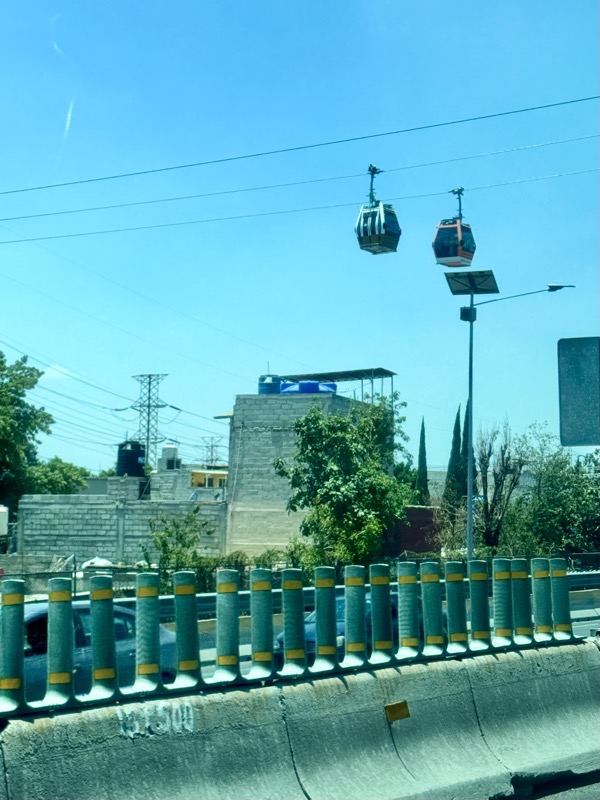
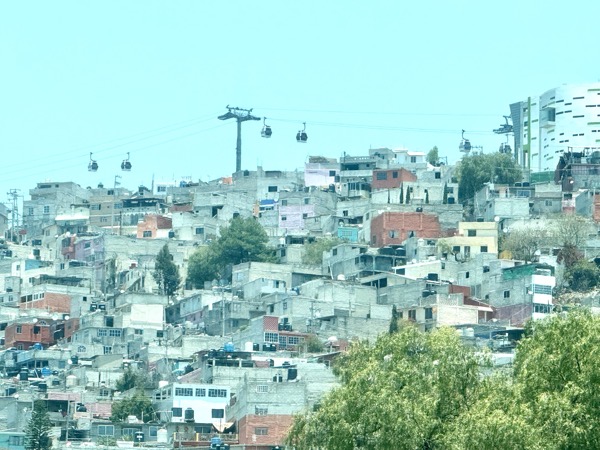
After about an hour of riding, we arrived at our destination: the Teotihuacan Pyramids, one of Mesoamerica’s most significant archaeological sites. Gerardo expertly navigated the maze of entry roads and gates, and before long, we found ourselves standing beside the Avenue of the Dead, gazing across at the towering 213-foot tall Pyramid of the Sun.
As we took in the sheer scale of this impressive monument, Gerardo explained that the original builders had fled here from the south, escaping the volcanic eruption of Popocatépetl. Upon settling in the valley, they discovered how the lunar cycle influenced the flow of water from the surrounding mountains. Over time, they developed systems to store and control this water—a critical advancement for the city’s survival. He noted that the Avenue of the Dead was not just a ceremonial path, but had originally functioned as a periodic waterway as well as a roadway through the city.
Gerardo came prepared with engaging props. He let us view the sun through a circular piece of obsidian, demonstrating the kind of tool ancient priests may have used. Using his tablet, he shared a series of images to supplement his explanations. He spoke about the mathematical and astronomical sophistication behind the Pyramid of the Sun and pointed out how its stairs and ledges subtly form the shape of a human figure with outstretched arms—a striking example of the builders’ symbolic design.
The Pyramid of the Sun served as a major religious and cultural center, symbolizing cosmic beliefs and political power in ancient Mesoamerica. Its massive scale, astronomical alignment, and influence on later civilizations highlight its significance in pre-Columbian history.
—— The Sun Pyramid at Teotihuacan ——
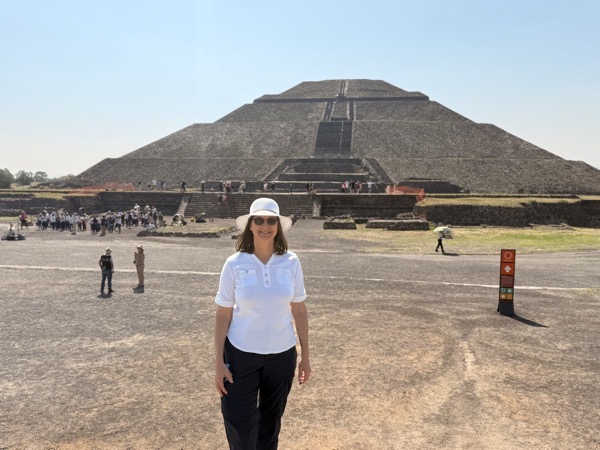
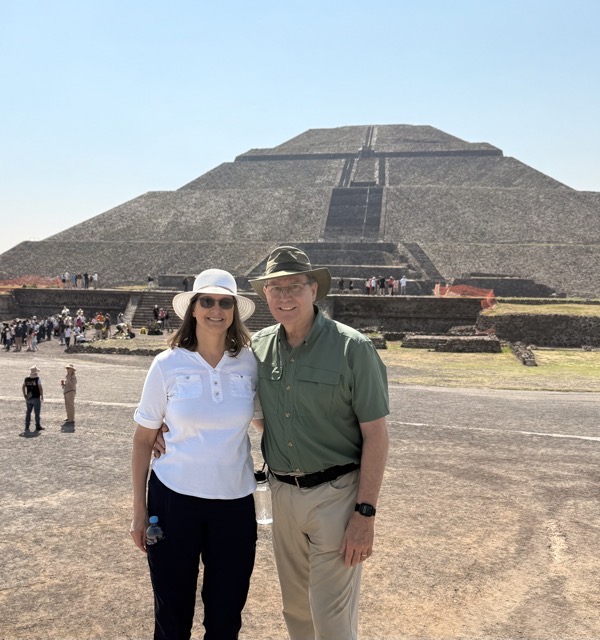

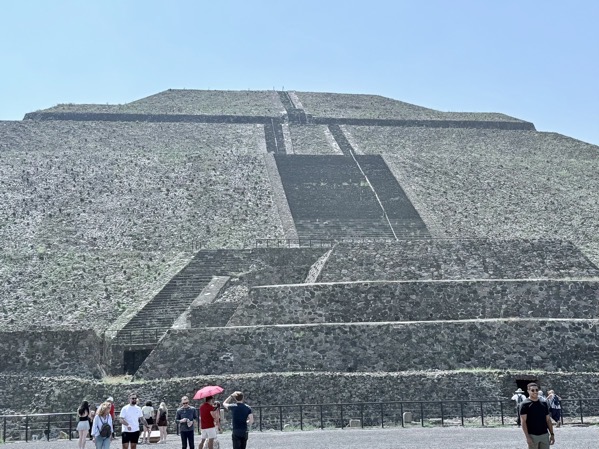
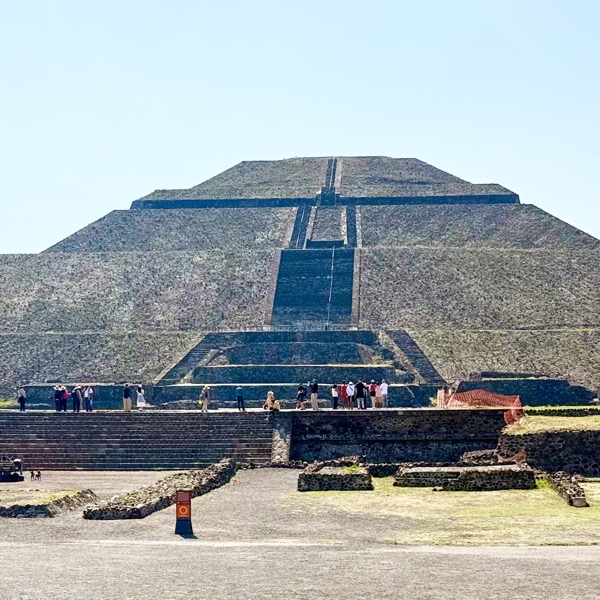
Gerardo then led us further south along the Avenue of the Dead, a broad thorough-fare that runs the length of Teotihuacan from the Pyramid of the Moon to the Pyramid of the Sun. As we paused to take in the sweeping view of the Western Plaza and distant mountains, he shared the significance of the twelve smaller pyramids that lined its perimeter. These structures, Gerardo explained, were likely used by pilgrims who traveled to Teotihuacan from distant regions, seeking spiritual connection and rituals.
Gerardo reached into his bag and pulled out a handful of seeds, scattering them on the ground. He explained that the original inhabitants of Teotihuacan may have sown seeds in this manner, allowing the water to carry them to distant lands where they would germinate and grow, a practice symbolizing the spread of life and culture.
As we continued to gaze down the vast expanse of the plaza, Gerardo pointed out intricate “valves” built into the ancient stonework, which were used to control the flow of water, ensuring the city’s irrigation system functioned properly. Imagining how this once vibrant city appeared in its heyday, with pilgrims bustling around the plaza and water flowing through the channels, was a surreal experience. It felt as though we were momentarily transported back in time, standing in the midst of an ancient ritual landscape that had played a key role in the spiritual and everyday lives of its inhabitants.
—— The Western Plaza —–
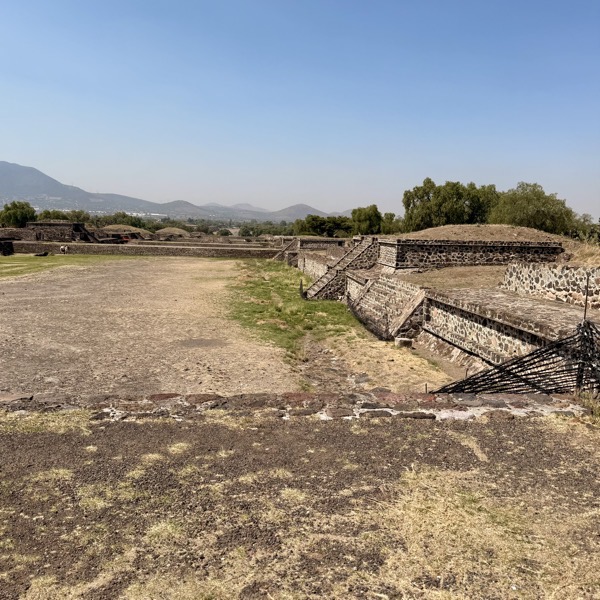
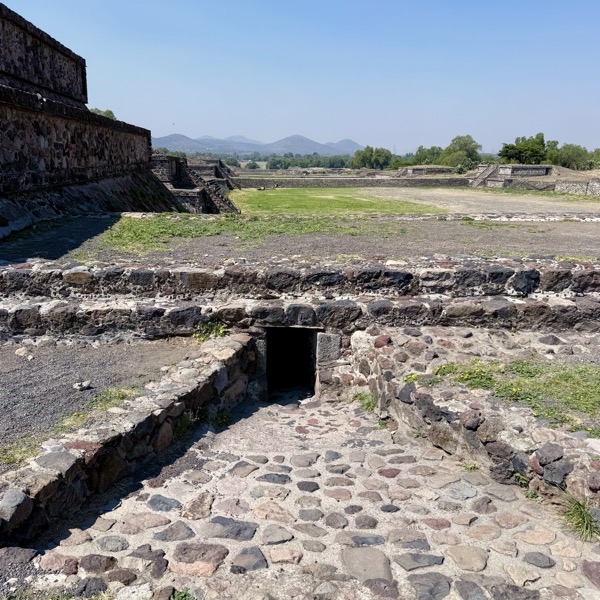
After our view of the Western Plaza, Gerardo led us closer to the majestic Pyramid of the Sun, guiding us to the base where he pointed out a door leading to a narrow corridor that stretched into the pyramid’s interior. As we examined the entrance, Gerardo pulled up a picture on his tablet, showing an aerial view of the pyramid’s lower levels. He explained that beneath the pyramid, four petal-shaped subterranean chambers had been constructed, each serving a distinct ritualistic purpose.
These chambers were likely designed to represent the underworld. Their shape and placement suggest they were symbolic of the four cardinal directions, with each chamber corresponding to a specific direction and its associated deity or power. The chambers were probably used for offerings, ceremonial rites, and possibly as burial sites for important individuals. The act of constructing these chambers beneath the pyramid likely reflected the belief in the sacred connection between the earth and the heavens, reinforcing the notion of the pyramid as a symbolic link between the mortal world and the divine.
Gerardo guided us through the walls at the base of the Pyramid of the Sun. While some sections had been reconstructed by archaeologists, these repairs were easy to identify by the small pebbles embedded in the mortar, a clear mark of modern intervention. He then led us to an area that, according to his knowledge, once featured an obsidian-lined bottom, suggesting it may have served as a pool. Pilgrims, Gerardo explained, would have gathered here to gaze upon the reflection of the heavens, seeking to achieve a sense of oneness with the gods. Although there is no concrete evidence to confirm this practice, the idea was deeply moving. Standing in that quiet, sacred spot, I couldn’t help but reflect on the possibility of such a profound ritual taking place, imagining the pilgrims connecting with the divine beneath the vast star-filled sky.
—— Front of the Pyramid of the Sun ——
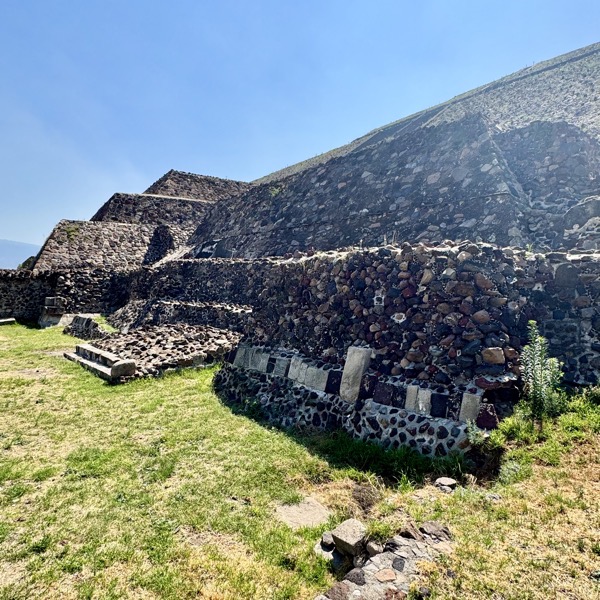
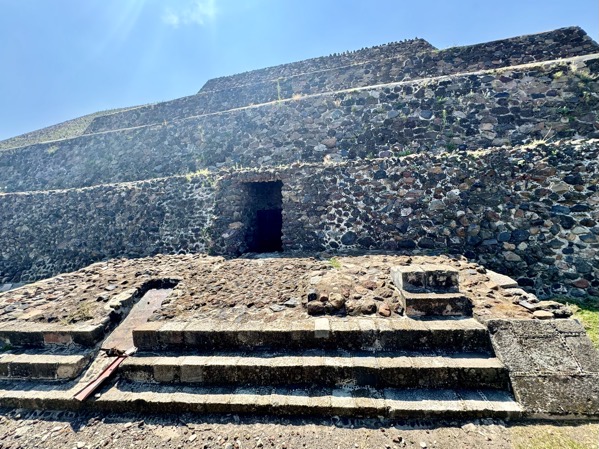
We continued our journey east along the Avenue of the Dead. Gerardo pointed out an intriguing and striking painting that adorned one of the stone surfaces lining the avenue. It depicted a puma, a powerful symbol in Mesoamerican cultures. This puma, often associated with strength, agility, and the natural world, was painted in bold, vivid colors, with its body gracefully curving as if in motion, capturing the essence of this majestic animal. The presence of this painting along such a significant path, the Avenue of the Dead, suggested that the puma was not just a creature of the natural world but a potent symbol in the ceremonial and cosmological landscape of Teotihuacan
We then arrived at the Pyramid of the Moon, the second-largest pyramid in Teotihuacan, standing at 141 feet tall. Located at the northern end of the Avenue of the Dead, it is believed to have been dedicated to the moon goddess, and its design reflects strong cosmological significance. The pyramid’s stepped, tiered structure ascends in several platforms, each likely serving a purpose in ceremonial rituals. Its alignment with the surrounding mountains, particularly Mount Tlaloc, suggests it played a central role in the spiritual practices of the Teotihuacanos.
At the base of the Pyramid of the Moon sits a prominent rock, worn by time. Gerardo shared that this weathered stone had been rolled down from the pyramid’s topmost platform during a ceremonial event. The stone bore the faint outline of a man carved into its surface, and a hollowed-out space that once held obsidian, adding a layer of mystery to its presence.
.—— The Moon Pyramid ——
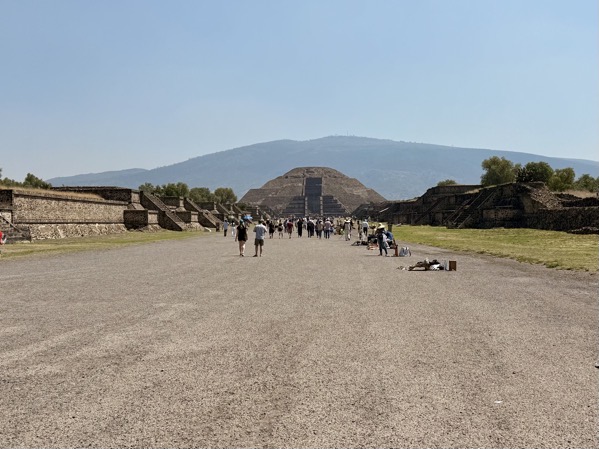
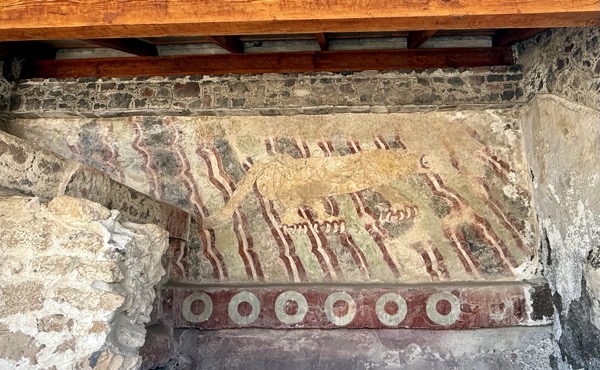
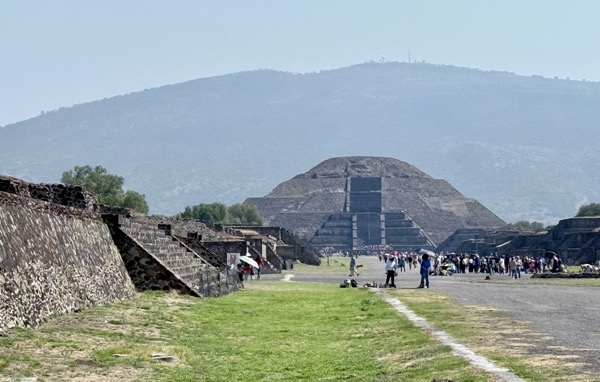
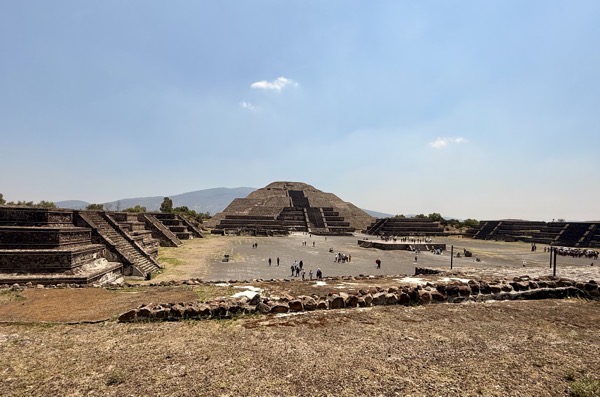
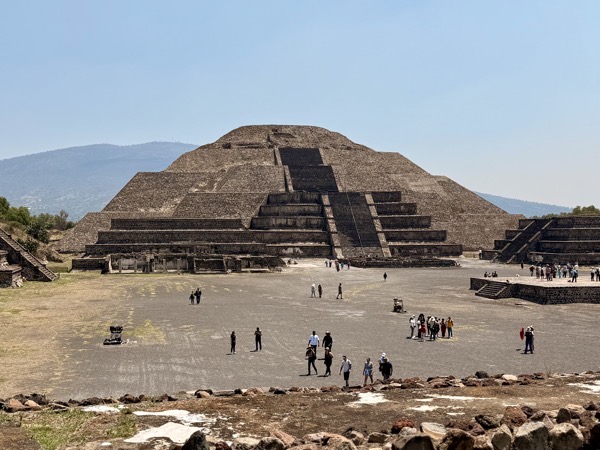
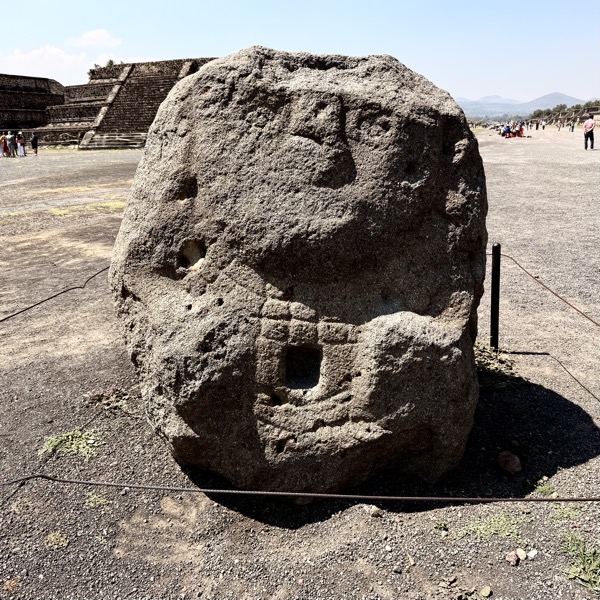
Next, we explored an area adjacent to the Pyramid of the Moon that had once served as the headquarters for priests. This sacred space included a plaza used for elaborate ceremonies, featuring sophisticated water-control systems designed to flood and clear the floor during ritual events. One area, Patio de los Jaguares y Caracoles Emplumados, had intricate carvings of jaguars and feathered serpents, symbols of power and spirituality in Teotihuacan.
Gerardo led us inside the Pyramid of the Moon for a glimpse of the pyramid’s internal structure. The chambers within were simple yet striking, with stone walls that have endured centuries of wear. Here, too, we observed ancient paintings and beautiful carvings on the pillars and walls.
—— Patio of the Jaguars and Inside the Pyramid of the Moon ——
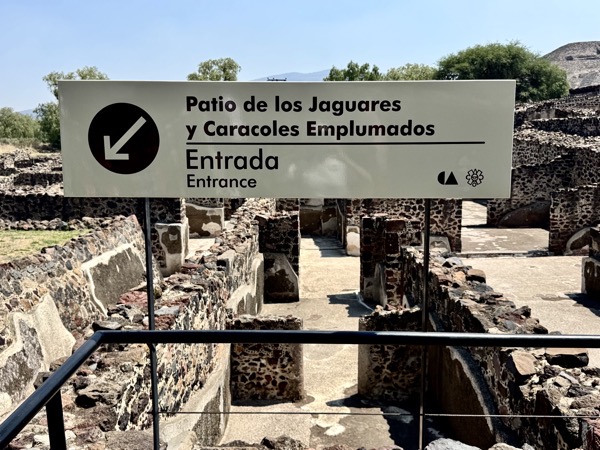
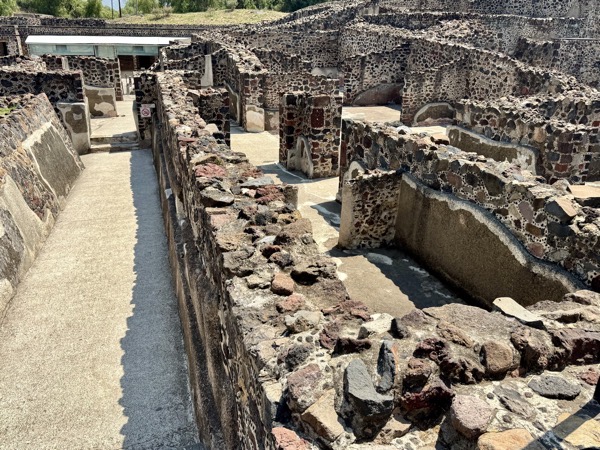
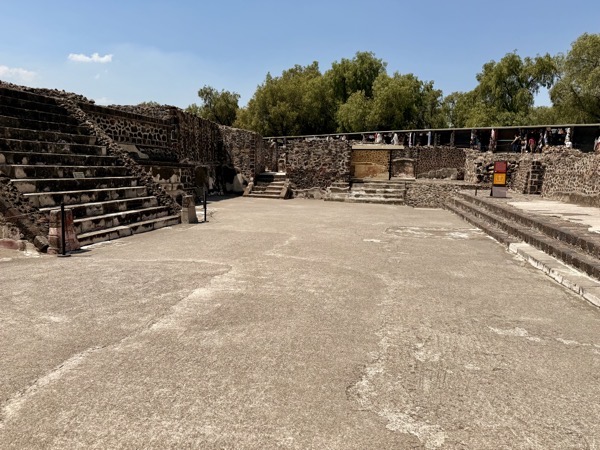
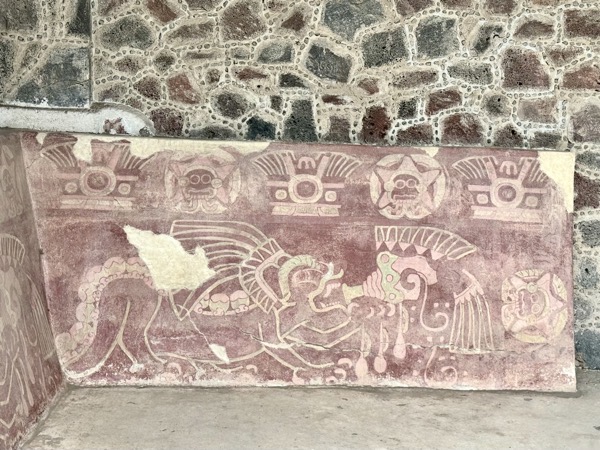
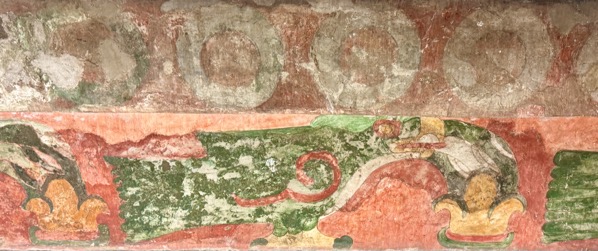
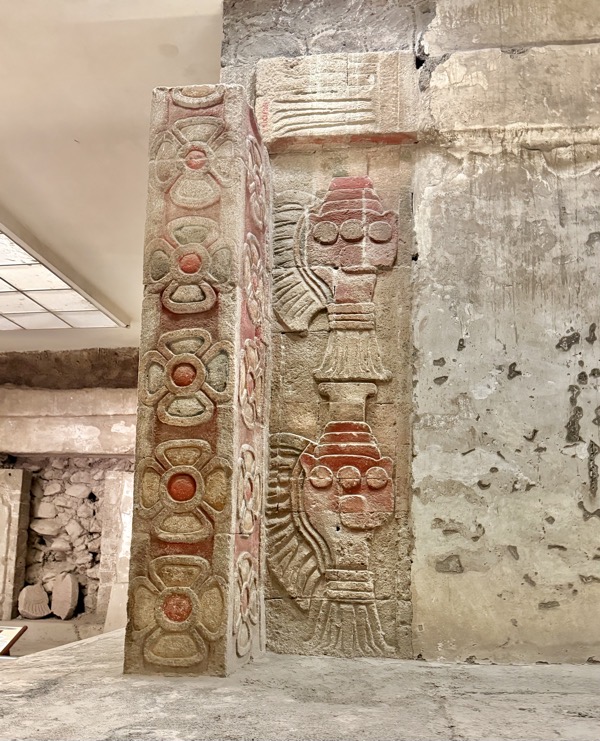
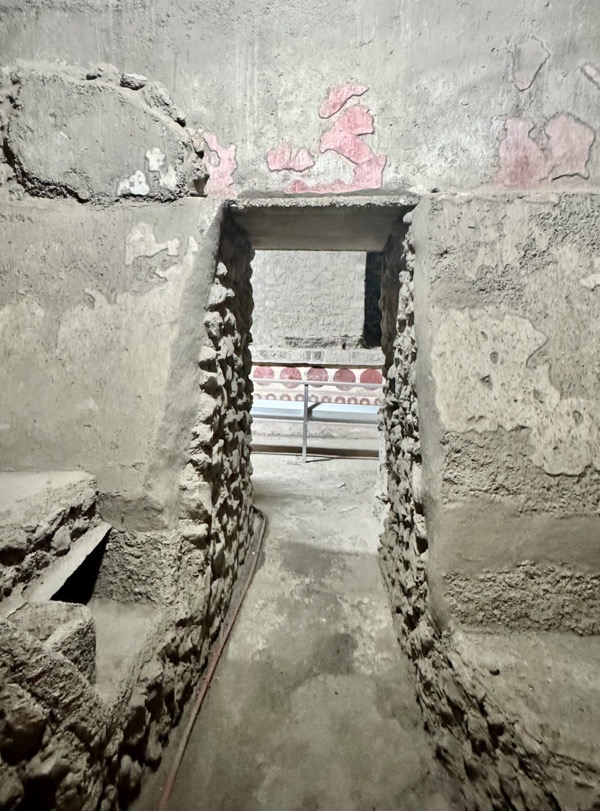
At this point, Gerardo gave us about 20 minutes to explore on our own while he retrieved his car to pick us up. We used the time to wander through the Patio of the Pillars, admire these remnants of ancient architecture, and climb a small nearby summit for a slightly elevated view of the Avenue of the Dead and its famous pyramids. We also browsed the many vendor stalls scattered between the Pyramid of the Moon and the parking areas, offering everything from handcrafted souvenirs to obsidian replicas. True to his word, Gerardo returned promptly, and before long, we were departing these sacred, awe-inspiring grounds—returning to the modern world and the harsh reality of Mexico City’s infamous traffic.
—— The Moon Pyramid – Patio of the Pillars ——
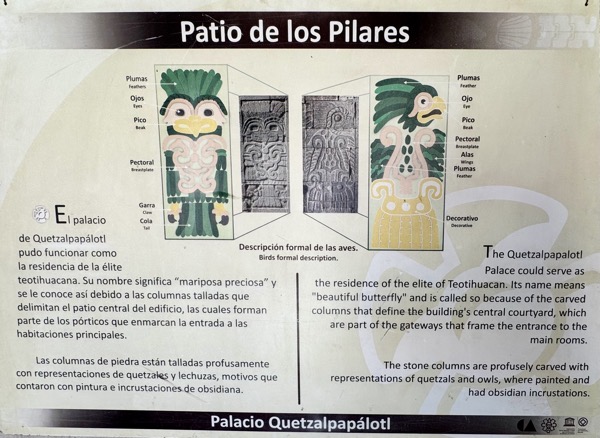
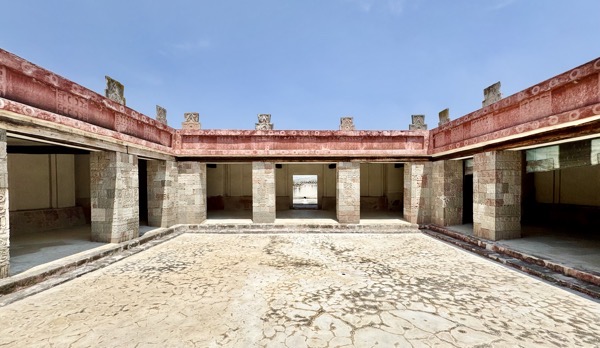
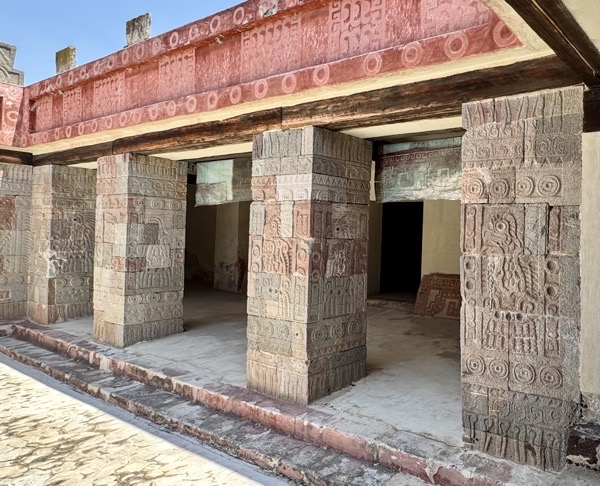
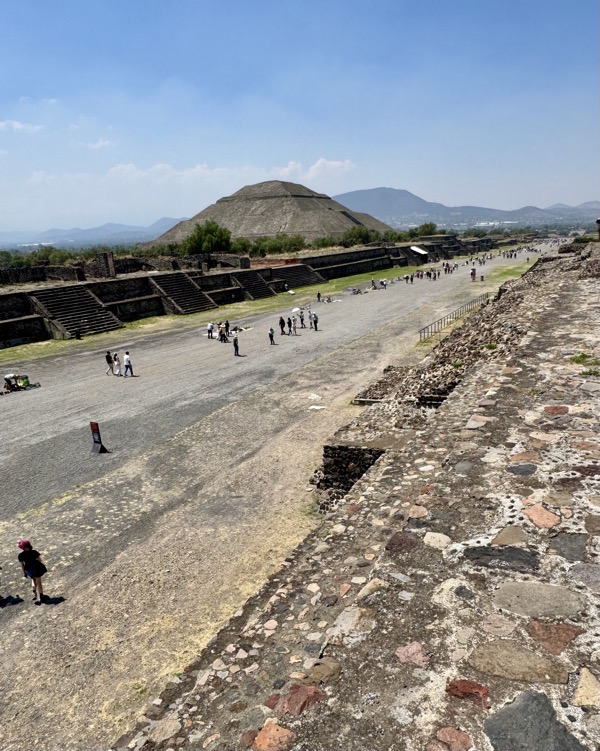

By the time we returned to the city, traffic had worsened significantly. At one point, Gerardo wisely chose an alternate route to avoid the sluggish congestion. As we approached our destination—the Basilica of Our Lady of Guadalupe—the road ahead was blocked due to construction, forcing yet another detour. After enduring nearly an hour and forty-five minutes of slow-moving traffic, Gerardo finally turned into the large parking deck reserved for the Basilica. We disembarked, grateful for the chance to stretch our legs at last.
Gerardo led us to the plaza of the Basilica of Our Lady of Guadalupe, a vast, stone-paved square that can hold tens of thousands of pilgrims at once. It is surrounded by chapels, statues, and gardens, and serves as a central gathering place for pilgrams. On major feast days, especially December 12th, the plaza becomes a sea of devotion, accommodating up to 50,000 people or more.
The eastern side of the plaza is home to the stately Old Basilica, with the Chapel of the Capuchinas standing just beside it. To the left of the Old Basilica, a prominent statue of Pope John Paul II honors his five visits and deep connection to the site.
Inside the Old Basilica, richly decorated altars, gilded retablos, and classical Baroque architecture create a solemn, majestic atmosphere. The high vaulted ceilings and ornate columns reflect centuries of devotion and craftsmanship. Gerardo led us to a couple of huge wall paintings and narrated the stories depicted in them.
—— Old Basilica —–
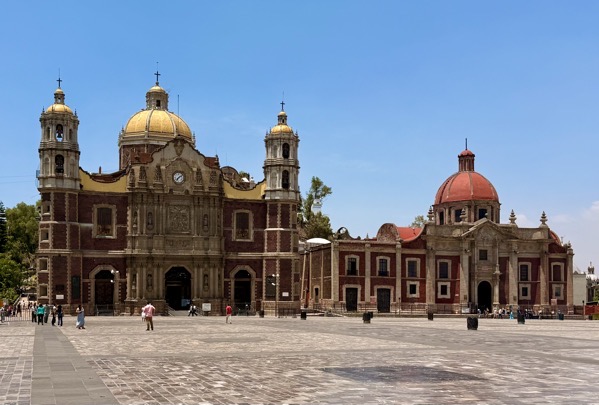
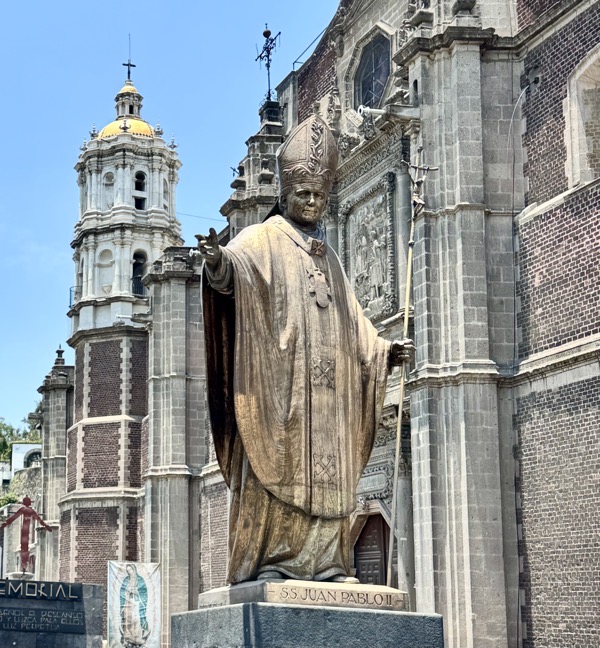
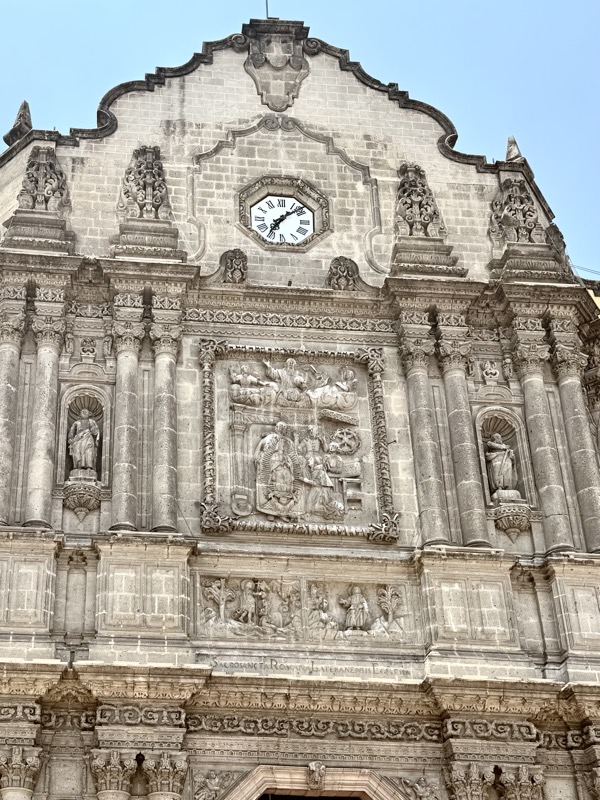
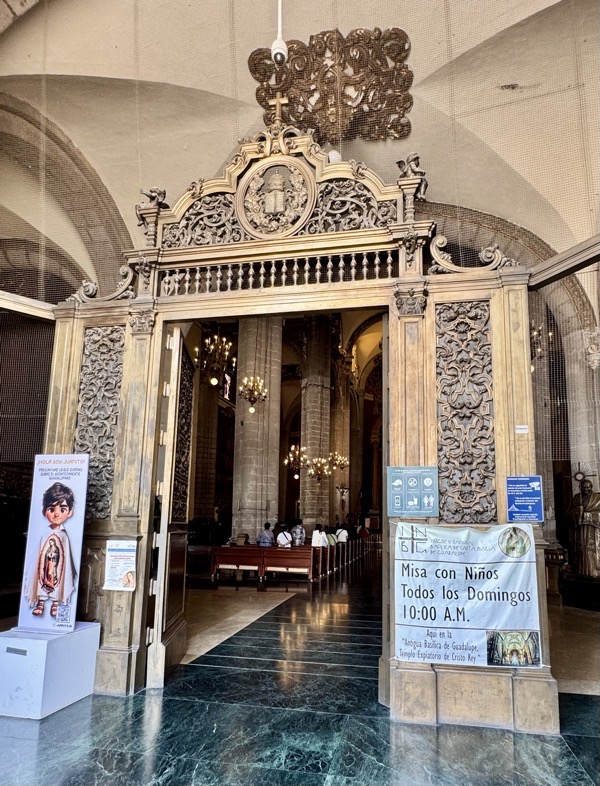
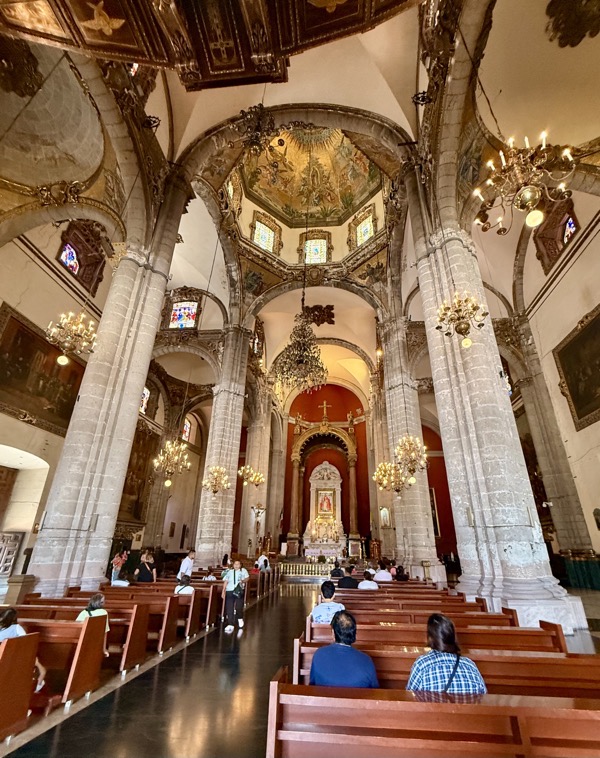

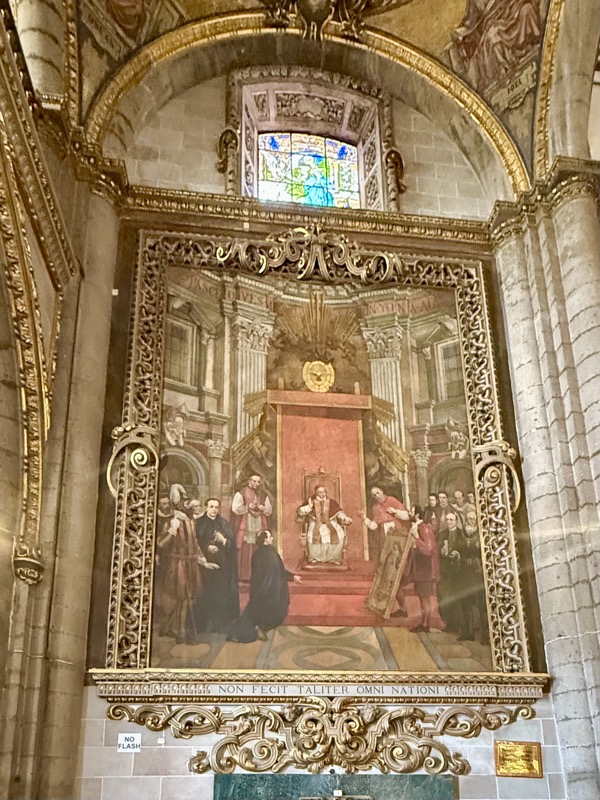
The Basilica of Our Lady of Guadalupe is the largest structure on the plaza, located on its northern side. Circular in design, the basilica can accommodate up to 10,000 worshipers. It honors Our Lady of Guadalupe, a title given to the Virgin Mary following a series of reported apparitions to an Indigenous man named Juan Diego in December 1531. According to tradition, the Virgin Mary appeared to Juan Diego on the nearby hill of Tepeyac and requested that a church be built in her honor. As a sign of her presence, she miraculously left her image imprinted on his cloak, or tilma—an artifact that is still preserved and displayed inside the basilica. Each year, more than 20 million Catholic pilgrims and visitors travel here to see it, making it one of the most visited religious sites in the world.
During our visit, we observed an ongoing worship service and caught a distant glimpse of the sacred image, which is displayed above and behind the main altar. Gerardo then led us to the rear of the sanctuary, where three short conveyor belts slowly glide beneath the framed tilma, allowing pilgrims (and curious tourists with cameras) to view it up close without crowding. We circled back for a second pass beneath the image to fully take it in before making our way out.
—— Balsilica of Our Lady of Guadalupe ——
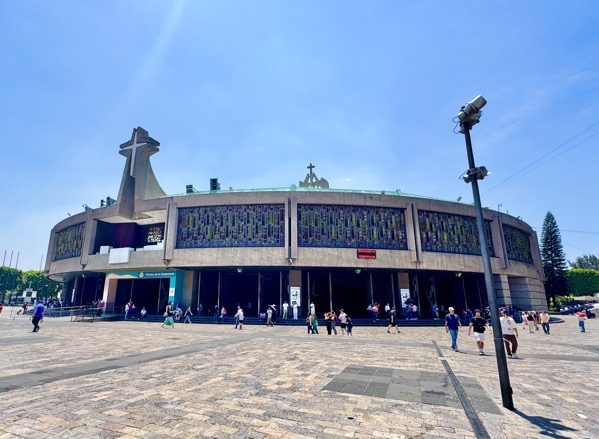
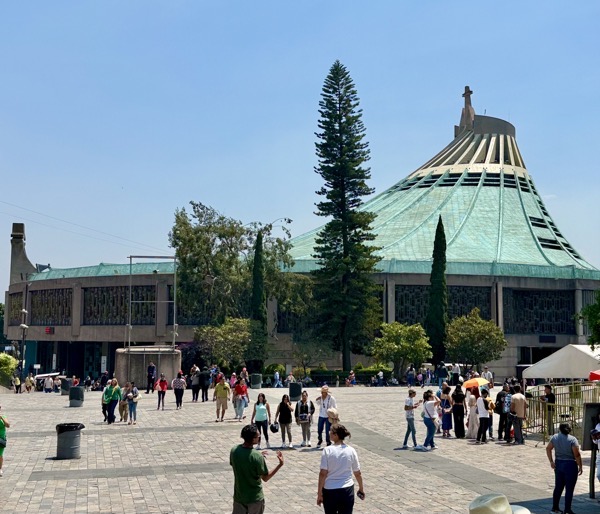
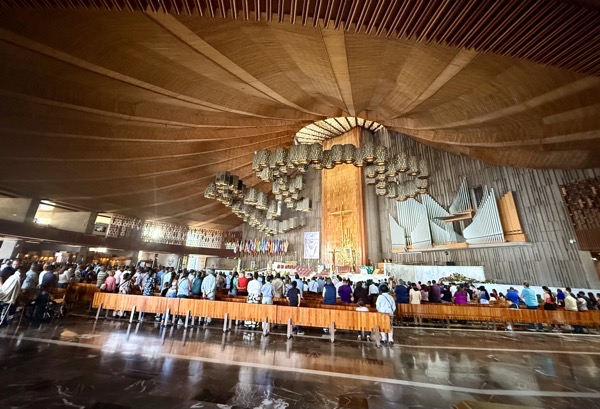
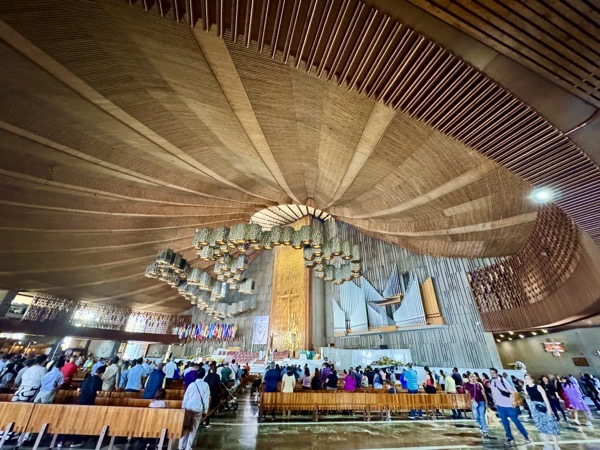
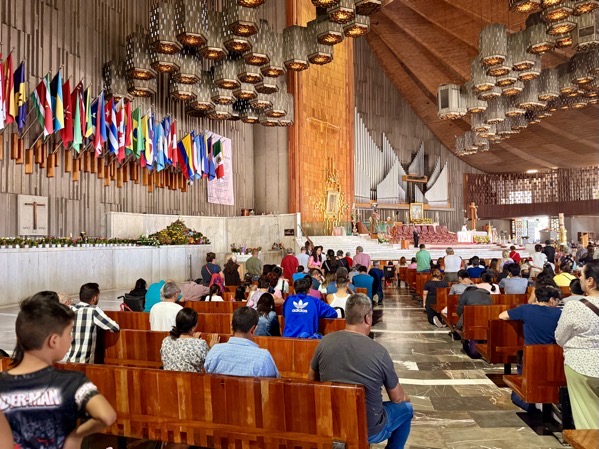

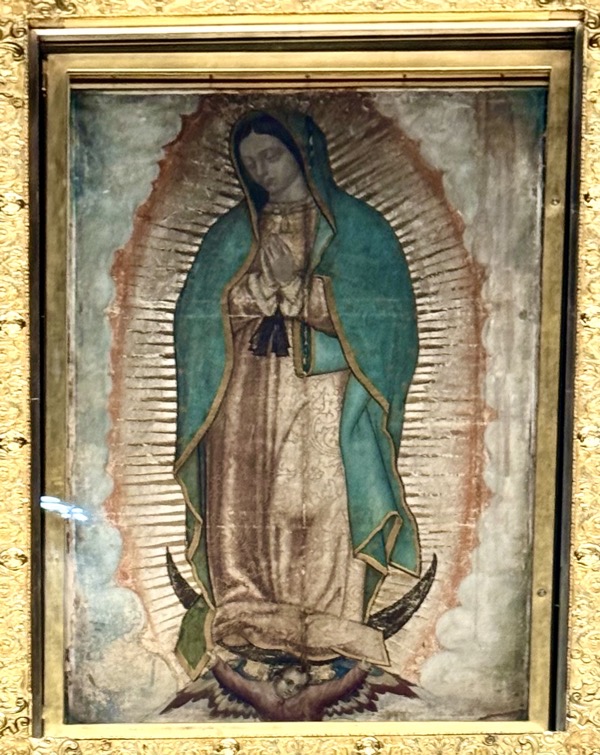
After exiting the Basilica, Gerardo guided us around the plaza and toward the Bautisterio, where we watched parents leading their young children to be baptized. We then visited the gardens behind the Basilica of Our Lady of Guadalupe, a peaceful area filled with lush greenery, fountains, and statues. These gardens are designed for prayer, reflection, and honoring the apparitions of the Virgin Mary to Juan Diego. They offer a quiet retreat from the crowds and provide visitors a space for contemplation and spiritual connection.
—— Walking around the Plaza ——
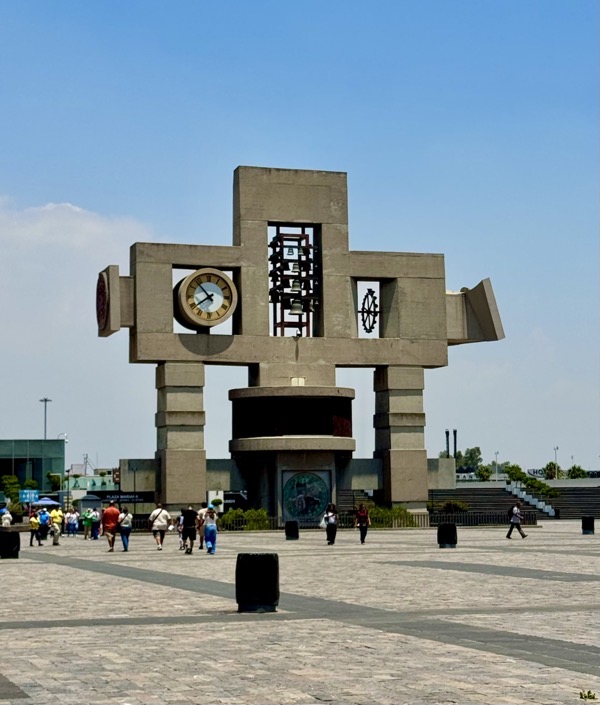
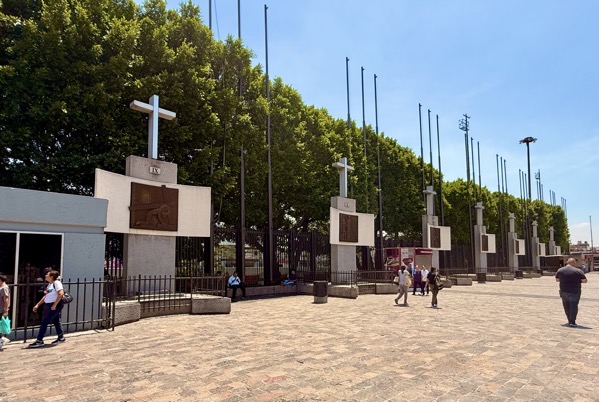
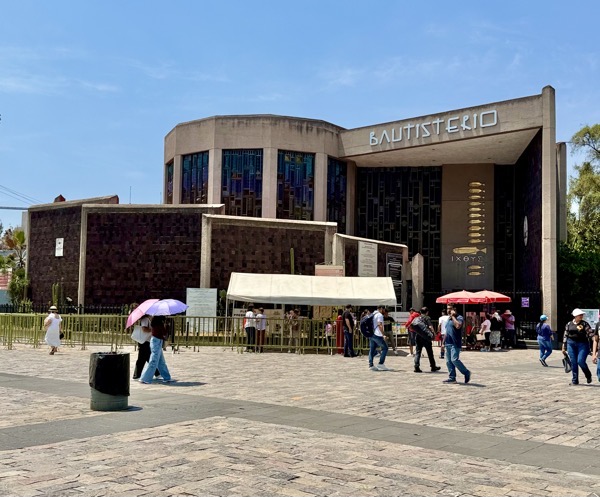
After another 45-minute bout with Mexico City traffic, Gerardo dropped us off in front of Durango 219. We expressed our deep appreciation for his guidance throughout the day and said our adioses.
After a brief rest in our room, we decided to head out for an early dinner, having skipped lunch. Just a short walk from our hotel, we made our way to the popular Contramar Seafood Restaurant. We arrived at 3:45 p.m. and, miraculously, were seated immediately at a window table.
We started with mineral water con gas and beers—Victoria for me, on the waiter’s recommendation, and a Nevada IPA for Jane. As an appetizer, we shared a shrimp ceviche-style dish, followed by several small plates: tuna tostaditas, soft-shell crab tacos, and fish tacos. For dessert, we indulged in house-made tarts—fig for Jane and banana for me.
Paulina, one of the three servers attending our table, stood out as the only female employee on the floor. Jane noticed and mentioned this, and Paulina appreciated the observation. The two shared a thoughtful moment reflecting on the dynamic.
We thoroughly enjoyed the vibrant (though noisy) atmosphere, the attentive service, and, most of all, the exceptional food at Contramar.
—— Contramar Seafood Restaurant —–
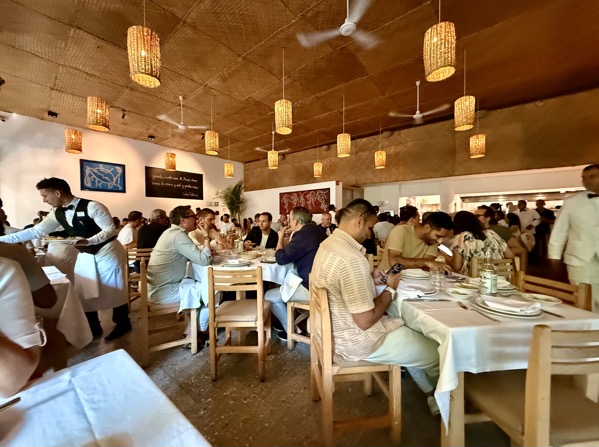
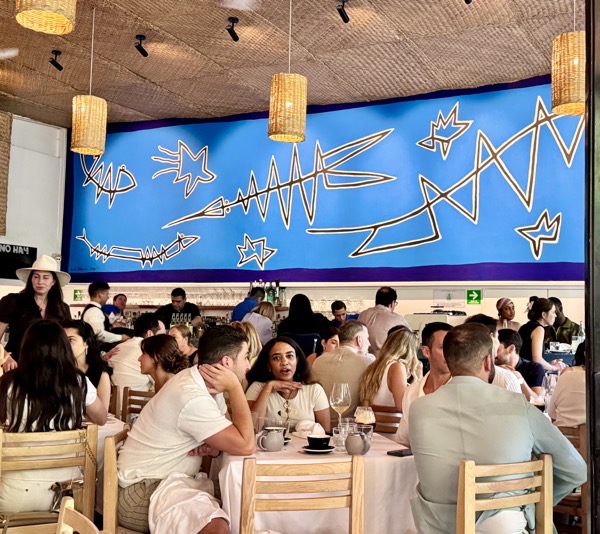
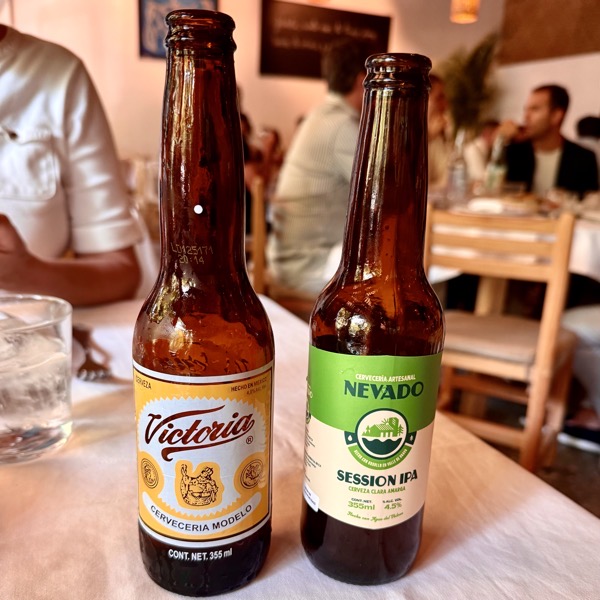

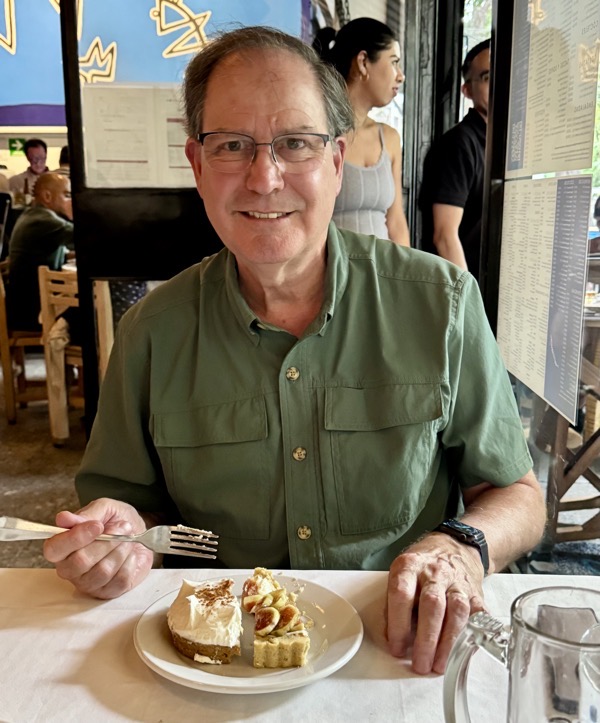
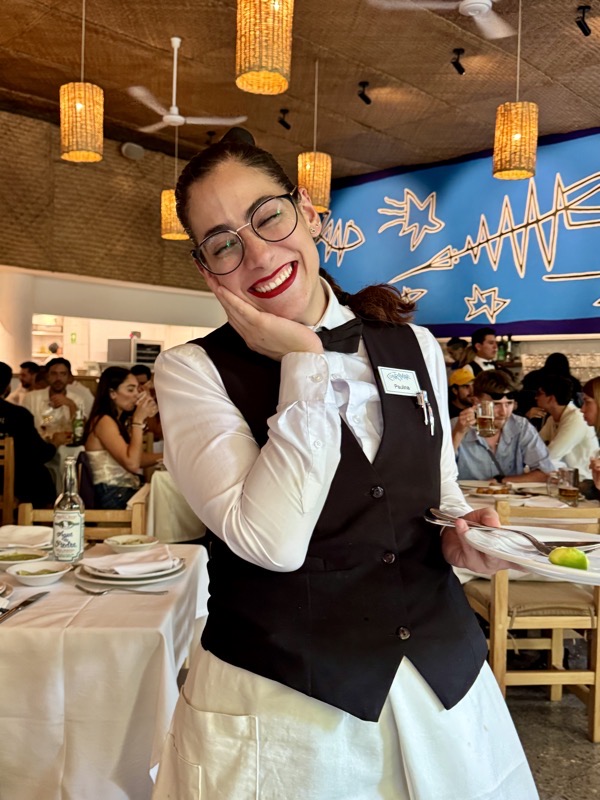
We slowly waddled out of the restaurant and dropped by the nearby OXXO for water and the pastery shop catty-corned across the intersection from our hotel, Casa 1900 Panaderia, before returning to our room to relax, reflect on the wonderful day, and anticipate tomorrow’s adventures.
—— Casa 1900 Pastry Shop ——

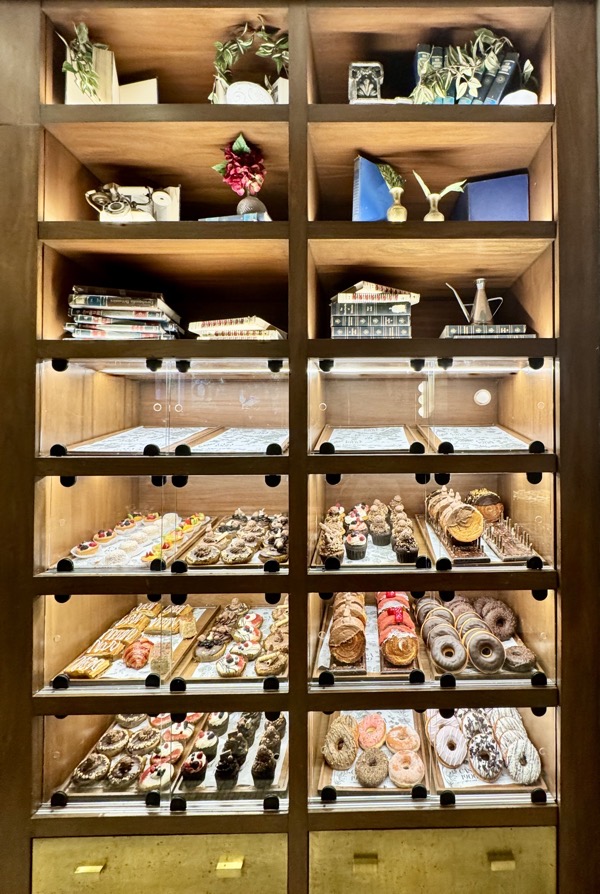
Very interesting. Those are the same pyramids I visited. Unfortunately, I was there with my youth group and we didn’t get to have a tour. I learned a lot from your blog. It makes me want to go back!
Yes, it was interesting and informative seeing them with a local guide. Hope you can make it back there someday.